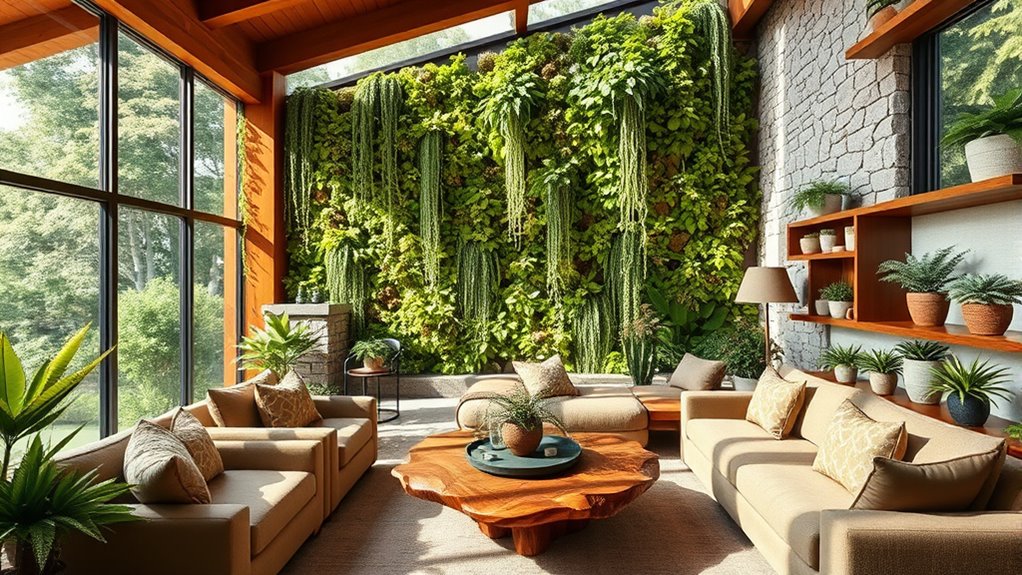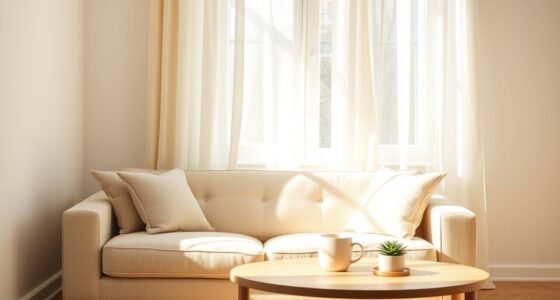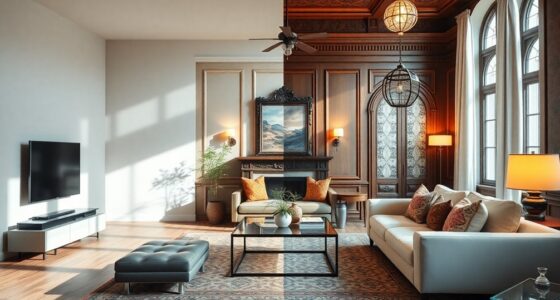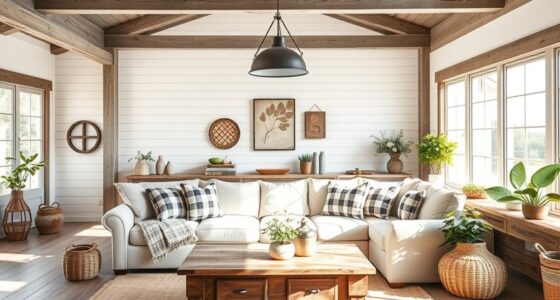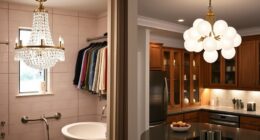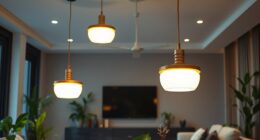Sustainable and biophilic design focuses on bringing natural elements into indoor spaces to improve your well-being and lessen environmental impact. By incorporating greenery, natural light, and organic materials like wood or bamboo, you create environments that feel calming and healthier. These approaches not only boost mood and comfort but also support eco-friendly practices. If you’re curious about how to seamlessly integrate nature indoors, you’ll find useful insights that can transform your space and lifestyle.
Key Takeaways
- Incorporate indoor greenery such as vertical gardens and plant walls to enhance air quality and create calming environments.
- Use natural materials like reclaimed wood and bamboo to reduce environmental impact and add warmth to interior spaces.
- Apply biophilic design principles by integrating natural light, organic shapes, and textures that mimic outdoor environments.
- Connect indoor spaces with outdoor elements to promote well-being and foster a stronger bond with nature.
- Prioritize sustainable practices in design choices to support eco-friendly lifestyles and minimize carbon footprint.
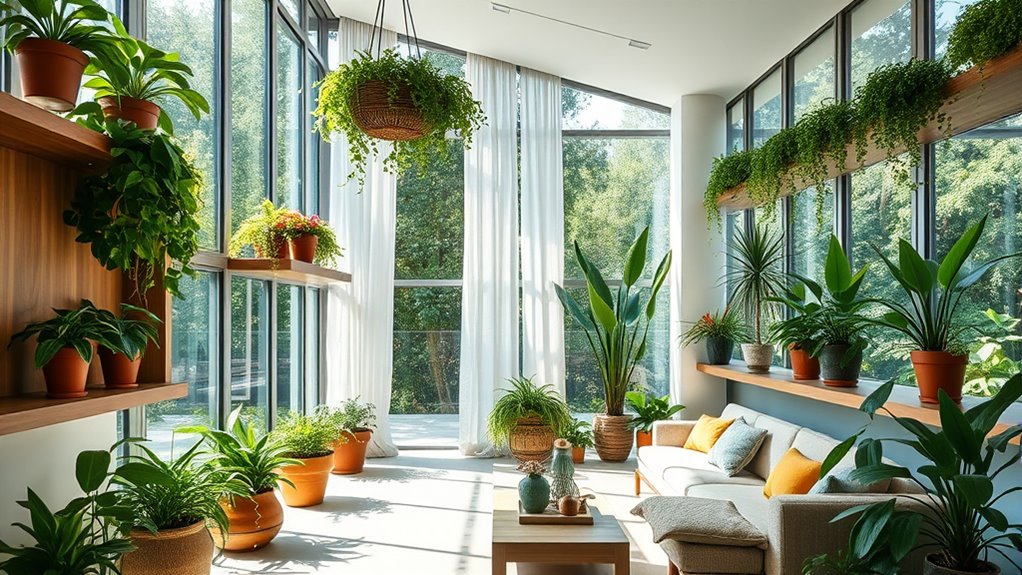
Have you ever wondered how design can positively impact both the environment and your well-being? When you incorporate sustainable and biophilic principles into your space, you create a environment that nurtures both nature and yourself. One of the most effective ways to achieve this is through urban greenery, which brings vibrant plant life into city settings, transforming concrete jungles into calming oases. Integrating urban greenery isn’t just about aesthetics; it improves air quality, reduces heat, and fosters a sense of tranquility. You can introduce vertical gardens, rooftop parks, or indoor plant walls to seamlessly blend nature into your daily surroundings. These elements serve as natural air filters and mood boosters, making your space healthier and more inviting. Incorporating urban greenery into your design helps establish a sustainable and biophilic environment that benefits both your well-being and the planet. Using natural materials plays a essential role in fostering a connection with nature and promoting sustainability. When you choose materials like wood, bamboo, cork, or reclaimed stone, you’re opting for options that have lower environmental impacts compared to synthetic alternatives. Natural materials bring warmth and texture to your environment, creating a soothing atmosphere that promotes relaxation and focus. They also tend to age gracefully, gaining character over time, which aligns with the principles of sustainable design by reducing waste. Incorporating these materials into furniture, flooring, or decorative accents not only enhances aesthetics but also supports eco-friendly practices, helping you minimize your carbon footprint. Biophilic design emphasizes creating spaces that mimic natural environments, making you feel more connected to the outdoors even when you’re indoors. By thoughtfully integrating elements such as natural light, organic shapes, and natural textures, you foster a sense of harmony and well-being. When you prioritize natural light, you benefit from improved mood and better circadian rhythms, which can boost your overall health. Choosing organic shapes and patterns reminiscent of nature helps your brain relax, reducing stress and increasing comfort. Combining these elements with urban greenery and natural materials creates a cohesive environment that nurtures both your physical and mental health. Ultimately, sustainable and biophilic design isn’t just about aesthetics; it’s about creating a space that actively enhances your life while respecting the planet. As you incorporate urban greenery and natural materials into your environment, you foster a healthier, more sustainable lifestyle. You’re not just decorating your space—you’re making a conscious choice to connect with nature, promote eco-friendly practices, and improve your well-being every day. This approach reminds you that good design can be powerful, transforming your environment into a sanctuary that supports and sustains both you and the planet.
Frequently Asked Questions
How Does Biophilic Design Impact Indoor Air Quality?
Biophilic design improves indoor air quality by enhancing air purification through natural elements like plants, which filter pollutants and increase oxygen levels. It also helps regulate humidity naturally, reducing excess moisture and mold growth. You’ll notice fresher, healthier air, which can boost your mood and productivity. By bringing nature inside, you create a more comfortable environment that supports your well-being and minimizes reliance on artificial air quality solutions.
What Are Cost-Effective Ways to Incorporate Nature Into Small Spaces?
You can incorporate nature into small spaces cost-effectively with DIY projects and budget-friendly plants. Start by creating wall planters or hanging gardens using repurposed containers. Choose easy-to-maintain, affordable plants like pothos or succulents that thrive indoors. Regularly caring for these plants improves air quality and adds a natural touch without spending much. This approach proves that integrating nature doesn’t have to break the bank—it’s simple and achievable.
How Does Sustainable Design Influence Long-Term Energy Savings?
Sustainable design boosts your long-term energy savings by enhancing energy efficiency and promoting resource conservation. You’ll use fewer resources through better insulation, energy-efficient windows, and smart systems that optimize heating, cooling, and lighting. These choices reduce your utility bills and environmental impact over time. By prioritizing sustainable practices, you create a space that’s not only eco-friendly but cost-effective, ensuring savings and reduced carbon footprint well into the future.
Can Biophilic Elements Be Customized for Different Cultural Preferences?
Think of biophilic elements as a garden that you can tailor to your cultural landscape. Yes, they can be customized through cultural adaptations and specific customization strategies, ensuring they resonate with diverse traditions and preferences. By blending local aesthetics with natural features, you create a space that feels both familiar and revitalizing. This thoughtful approach fosters a deeper connection, making nature’s benefits accessible and meaningful across different cultural contexts.
What Maintenance Is Required for Living Plant Installations Indoors?
You’ll need to regularly water your indoor plant installations to keep them healthy, typically once or twice a week, depending on the plant type. Keep an eye out for pests and perform pest control as needed to prevent infestations. Also, prune dead leaves, check soil moisture levels, and guarantee proper lighting. Consistent maintenance like these helps your plants thrive and keeps your indoor environment vibrant and inviting.
Conclusion
Think of your space as a garden you tend to daily. By embracing sustainable and biophilic design, you’re planting seeds of harmony where nature and innovation flourish together. With each mindful choice, you nurture a sanctuary that breathes life into your environment, much like a gardener tending to vibrant blooms. When you bring nature indoors, you create a resilient oasis—an enduring demonstration to how human ingenuity and Earth’s beauty grow side by side.
